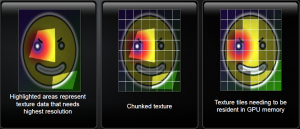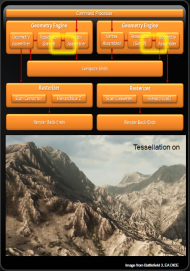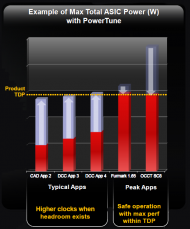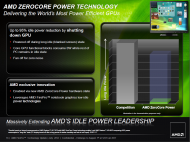Today AMD announced the availability of its next generation of FirePro workstation GPUs. The new GPUs are members of the same Southern Islands family of graphics cards, and just like their Radeon counterparts did for gaming, the FirePro line brings a new set of technologies to the table for the workstation graphics user.
The technology behind the new FirePro series
GCN
The W-series FirePro cards use AMD’s Graphics Core Next (GCN) architecture that was first introduced in the Radeon HD 7000 series gaming GPUs. This architecture is built of a 28nm process and provides unified graphics processing and compute cores, which should mean excellent graphics and compute performance. The 28nm process allows 4.3 billion transistors to be packed into the same space once needed to hold 2.6 billion transistors. Each FirePro card comes equipped with up to 32 compute units containing a scalar coprocessor and, combined with GPU-aware programming languages such as C++ AMP and OpenCL, giving GCN a huge boost in GPU-accelerated tasks.
PCI Express 3.0
The biggest benefit to PCI Express 3.0 is the doubled bandwidth over the PCI Express 2.X specification, topping out at 32GB/s for a 16-lane slot. This breaks down to 1GB/s per lane in each direction. This bandwidth doubling becomes especially important as increasingly large and complex workloads are transferred to the FirePro for processing.
Partially Resident Textures (PRT)
PRT enables future applications to utilize ultra-high resolution textures with the same performance as today’s small and often repetetive textures. This is because increasing the physical size or number of textures used can have a negative impact on rendering performance. PRT can utilize data sets of up to 32TB with minimal performance impact. This is accomplished by streaming small bits of the data set into the GPU as needed, giving compatible applications a virtually endless supply of data that can be applied to the scene being rendered.
 Basically, local graphics memory now behaves more like a hardware/software managed cache. Textures are broken into 64KB tiles, regardless of texture type or format. Areas of the texture that have more detail, and therefore need a higher resolution, are identified, broken into 64KB chunks, and are marked as needing to stay resident in the GPU memory.
Basically, local graphics memory now behaves more like a hardware/software managed cache. Textures are broken into 64KB tiles, regardless of texture type or format. Areas of the texture that have more detail, and therefore need a higher resolution, are identified, broken into 64KB chunks, and are marked as needing to stay resident in the GPU memory.
Bonus points: for the ultra nerdy graphics programmers out there, this function is enabled via the OpenGL AMD_sparse_texture Extension.
Improved Tessellation
 Media and entertainment applications are naturally pushing the envelope of realism by utilizing a greater degree of special rendering effects. One such effect is tessellation, which can dynamically generate additional details in a scene on the fly. Tessellation isn’t new to the GPU, but the manner in which it is executed can have a large impact on the user experience.
Media and entertainment applications are naturally pushing the envelope of realism by utilizing a greater degree of special rendering effects. One such effect is tessellation, which can dynamically generate additional details in a scene on the fly. Tessellation isn’t new to the GPU, but the manner in which it is executed can have a large impact on the user experience.
GCN improves its tessellation features over the previous generation’s architecture through increased vertex re-use, off-chip buffering improvements, and larger parameter caches (on-chip storage between tessellation output and consuming pixel shaders). If your eyes didn’t just glaze over, the new tessellation technology translate to an “up to” 4x throughput improvement over the previous generation.
AMD PowerTune Technology
 Just like their Radeon HD counterparts, FirePro workstation GPUs are designed to draw only a certain amount of power. This is called the Thermal Design Profile (TDP), and it is critical that a GPU be able to take advantage of every last watt available to it. PowerTune is an intelligent system that performs real-time analysis of the applications currently utilizing the GPU. If an application is not making the most of the power available to the GPU, PowerTune can improve performance by raising the GPU’s clock speed by up to 15%. PowerTune is completely automatic and transparent to the user.
Just like their Radeon HD counterparts, FirePro workstation GPUs are designed to draw only a certain amount of power. This is called the Thermal Design Profile (TDP), and it is critical that a GPU be able to take advantage of every last watt available to it. PowerTune is an intelligent system that performs real-time analysis of the applications currently utilizing the GPU. If an application is not making the most of the power available to the GPU, PowerTune can improve performance by raising the GPU’s clock speed by up to 15%. PowerTune is completely automatic and transparent to the user.
AMD ZeroCore Power Technology
 AMD’s ZeroCore Power Technology can be seen as a complement to their PowerTune technology. Where PowerTune raises clock speeds when room exists within the TDP, ZeroCore completely powers the GPU down when your monitor is off and the rest of the system is in an active idle state (doing nothing, but still turned on). ZeroCore maintains a very small portion of the GPU hardware to ensure the GPU is still visible to the operating system and BIOS. It also manages the power sequencing of the GPU to ensure that the power up/down mechanism is self-contained and independent of the rest of the the system. It’s not limited to the monitor being turned off, either. If applications are not updating display contents or using background GPU resources, the GPU is put into the ZeroCore power state once the system is in long idle. If an application updates the screen, the driver can wake the GPU long enough to perform the update, then it sends the GPU back to sleep.
AMD’s ZeroCore Power Technology can be seen as a complement to their PowerTune technology. Where PowerTune raises clock speeds when room exists within the TDP, ZeroCore completely powers the GPU down when your monitor is off and the rest of the system is in an active idle state (doing nothing, but still turned on). ZeroCore maintains a very small portion of the GPU hardware to ensure the GPU is still visible to the operating system and BIOS. It also manages the power sequencing of the GPU to ensure that the power up/down mechanism is self-contained and independent of the rest of the the system. It’s not limited to the monitor being turned off, either. If applications are not updating display contents or using background GPU resources, the GPU is put into the ZeroCore power state once the system is in long idle. If an application updates the screen, the driver can wake the GPU long enough to perform the update, then it sends the GPU back to sleep.
Oh, and the fan turns off when ZeroCore is active.
Of product merges and cost advantages
AMD formerly used two professional graphics products lines: the FirePro line was typically used to handle heavy-duty graphics task, while the FireStream line was aimed at more generalized GPGPU tasks. As of the new FirePro line, the FireStream brand is going away in favor of a single unified product brand. Their primary reason for doing so is that the GCN architecture is suitable for handling both compute and graphics workloads…simultaneously. A secondary benefit is significant cost savings in the form of lower hardware requirements for a wider array of tasks.
The FirePro W-series GPUs are able to process two compute tasks and one render task per clock—something that their competition requires two separate cards (Quadro and Tesla) to accomplish. AMD really drove this point home when comparing workstation costs to handle similar workloads. Because the FirePro GPU is able to handle both compute and rendering tasks simultaneously, only one GPU is required.
Another area of cost savings is multi-display setups. As of product launch, AMD FirePro is still the only workstation GPU that supports six displays on a single card. NVIDIA requires a new GPU for every two displays used. Additionally, Eyefinity is supported on the FirePro line and the display grouping options are just as flexible as the desktop line.
The Models
AMD is introducing four new members of the FirePro line today, covering the entire range of price points for workstation graphics.
| FirePro W9000 | FirePro W8000 | FirePro W7000 | FirePro W5000 | |
|---|---|---|---|---|
| MSRP | $3999 | $1599 | $899 | $599 |
| Form factor | Dual slot | Dual slot | Single slot | Single slot |
| GPU Family | Tahiti GL-XT | Tahiti GL-PRO | Pitcairn GL-XT | Pitcairn GL-PRO |
| Compute Units | 32 | 28 | 20 | 12 |
| Shader Processors | 2048 | 1792 | 1280 | 768 |
| Texture Units | 128 | 112 | 80 | 48 |
| Render Output Units | 32 | 32 | 32 | 32 |
| Core Clock | 975MHz | 900MHz | 950MHz | 825MHz |
| Memory Clock | 1375MHz | 1375MHz | 1200MHz | 800MHz |
| Memory Size | 6GB GDDR5 | 4GB GDDR5 | 4GB GDDR5 | 2GB GDDR5 |
| Memory Bus | 384-bit | 256-bit | 128-bit | 128-bit |
| Memory Bandwidth | 264GB/s | 176GB/s | 153.6GB/s | 102.4GB/s |
| TDP | <274W | <189W | <150W | <75W |
| TFLOPS (single/double precision) |
3.99 single precison 1.00 double precision |
3.23 single precision 0.81 double precision |
2.43 single precision 0.152 double precision |
1.86 single precision 0.079 double precision |
| Pixel Fillrate | 31.2 GPixel/s | 28.8 GPixel/s | 30.4 GPixel/s | 26.4 GPixel/s |
| Texture Fillrate | 124.8 GTexel/s | 100.8 GTexel/s | 76 GTexel/s | 39.6 GTexel/s |
| Max texture size (pixels) | 16K x 16K | |||
| AntiAliasing | 24x MSAA | |||
| Anisotropic Filtering | Improved 16x | |||
| Stereoscopic | 3-pin mini-DIN | |||
| Display Color | 30-bit | |||
| CrossFire Pro support | Yes | |||
| DisplayPort/HDMI Audio | DDMA multiple 7.1 192KHz 24-bit |
|||
| Shader Model | SM5.0 | |||
| OpenGL | 4.2 | |||
| DirectX | 11.1 | |||
| OpenCL | 1.2 | |||
| Video Encode | H.264 4Kx2K | |||
| PCI Express Support | 3.0 x16 | |||
| Display Outputs | 6x Mini DisplayPort 1.2 | 4x DisplayPort 1.2 | 4x DisplayPort 1.2 | 2x DisplayPort 1.2 1x Dual-Link DVI |
| Maximum Displays | 6 | 6* | 6* | 6* |
| Warranty | 3 year | |||
*requires the use of a DisplayPort MST (hub)
Software and hardware parnters
 AMD isn’t just bringing a set of shiny GPUs to the table and leaving it at that; hardware and software vendors were on hand to demonstrate their support for the AMD FirePro GPU. Dell and HP have both announced certified workstation lines featuring the new AMD FirePro GPUs. A wide range of software vendors covering the CAD/CAE, Scientific Computing, Rendering, and Video Broadcasting industries have built in support for FirePro.
AMD isn’t just bringing a set of shiny GPUs to the table and leaving it at that; hardware and software vendors were on hand to demonstrate their support for the AMD FirePro GPU. Dell and HP have both announced certified workstation lines featuring the new AMD FirePro GPUs. A wide range of software vendors covering the CAD/CAE, Scientific Computing, Rendering, and Video Broadcasting industries have built in support for FirePro.
…and now for something completely different
AMD is serious about hitting every market segment with the FirePro brand, and it doesn’t stop at the conventional workstation.
Imagine, if you will, a graphics or scientific workstation that doesn’t contain a PCI Express GPU. As you might imagine, this would be a pretty painful thing since the CPU is so much slower than the GPU at these tasks. These tasks just aren’t designed for use on an IGP-style system, yet in developing markets and small companies with limited budgets this is a daily reality. AMD has a rather surprising solution—the AMD FirePro A300 series Accelerated Processor (APU).
 Typically, AMD’s APUs have been used in home systems ranging from HTPCs to laptops and even inexpensive desktop systems. Now they are an option in entry-level workstations where cost is often a severely limiting factor.
Typically, AMD’s APUs have been used in home systems ranging from HTPCs to laptops and even inexpensive desktop systems. Now they are an option in entry-level workstations where cost is often a severely limiting factor.
The A300 APU combines Piledriver x86 cores with FirePro (Cayman 6900 series) workstation graphics all on one processor package, and promises more powerful graphics performance than entry-level options such as the NVIDIA Quadro 600 discrete GPU. The low cost allows new workstation options that deliver an excellent balance of CPU, GPU, and system-level performance for today’s entry and mainstream design workflows.
The GPU side of the APU can use up to 2GB of system RAM, supports all the same standards as its PCI Express counterparts (DirectX 11.1, OpenGL 4.2, OpenCL 1.1, etc), and significantly outperforms any other on-die GPU currently available. Up to four displays can be used whenever a DisplayPort MST hub is finally released.
While concrete pricing information couldn’t be discussed, it wouldn’t be out of the realm of possibility to see an A300-based workstation priced at or below the cost of their least expensive FirePro cards. Dozens of system vendors are expected to announce designs on launch day and shortly after, so the pricing question should be answered quickly enough.
Wrap up
All four of the AMD FirePro workstation GPUs will be available starting today at the price points mentioned above, while workstations featuring the AMD FirePro A300 APU should hit the market soon. Icrontic has both the FirePro W9000 and W8000 in hand and they’re currently being put through the benchmark suite. Performance reviews of both GPUs will be posted soon.







 Articles RSS
Articles RSS